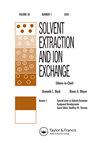Uranyl Speciation in the Presence of Specific Ion Gradients at the Electrolyte/Organic Interface
IF 2.1
4区 化学
Q3 CHEMISTRY, MULTIDISCIPLINARY
引用次数: 5
Abstract
ABSTRACT Uranyl (UO ) speciation at the liquid/liquid interface is an essential aspect of the mechanism that underlies its extraction as part of spent nuclear fuel reprocessing schemes and environmental remediation of contaminated legacy waste sites. Of particular importance is a detailed perspective of how changing ion concentrations at the liquid interface alter the distribution of hydrated uranyl ion and its interactions with complexing electrolyte counterions relative to the bulk aqueous solution. In this work, classical molecular dynamics simulations have examined uranyl in bulk LiNO and in the presence of a hexane interface. UO is observed to have both direct coordination with NO and outer-sphere interactions via solvent-separated ion-pairing (SSIP), whereas the interaction of Li with NO (if it occurs) is predominantly as a contact ion-pair (CIP). The variability of uranyl interactions with nitrate is hypothesized to prevent dehydration of uranyl at the interface, and as such the cation concentration is unperturbed in the interfacial region. However, Li loses waters of solvation when it is present in the interfacial region, an unfavorable process that causes a Li depletion region. Although significant perturbations to ion–ion interactions, solvation, and solvation dynamics are observed in the interfacial region, importantly, this does not change the association constants of uranyl with nitrate. Thus, the experimental association constants, in combination with knowledge of the interfacial ion concentrations, can be used to predict the distribution of interfacial uranyl nitrate complexes. The enhanced concentration of uranyl dinitrate at the interface, caused by excess adsorbed NO , is highly relevant to extractant ligand design principles as such nitrate complexes that are the reactants in ligand complexation and extraction events.电解质/有机界面上特定离子梯度存在下的铀酰形态
铀酰(UO)在液/液界面的形态形成是其提取机制的一个重要方面,它是乏核燃料后处理方案和污染遗留废物场地环境修复的一部分。特别重要的是一个详细的角度,如何改变离子浓度在液体界面上改变水合铀酰离子的分布及其与络合电解质反离子相对于整体水溶液的相互作用。在这项工作中,经典分子动力学模拟已经检查了铀酰在散装LiNO和存在一个己烷界面。研究发现,UO既与NO直接配位,又通过溶剂分离离子对(SSIP)进行外球相互作用,而Li与NO的相互作用(如果发生)主要是作为接触离子对(CIP)进行的。假设铀酰与硝酸盐相互作用的可变性可以防止界面处铀酰的脱水,因此界面区域的阳离子浓度不受干扰。然而,当它存在于界面区域时,Li失去了溶剂化水,这是一个不利的过程,导致Li耗尽区。虽然在界面区域观察到对离子-离子相互作用、溶剂化和溶剂化动力学的显著扰动,但重要的是,这并没有改变铀酰与硝酸盐的结合常数。因此,结合对界面离子浓度的了解,实验缔合常数可以用来预测界面硝酸铀酰配合物的分布。过量的NO吸附导致界面处硝酸铀酰浓度升高,这与萃取剂配体设计原则密切相关,因为硝酸盐配合物是配体络合和萃取事件的反应物。
本文章由计算机程序翻译,如有差异,请以英文原文为准。
求助全文
约1分钟内获得全文
求助全文
来源期刊
CiteScore
4.40
自引率
5.00%
发文量
15
审稿时长
8.4 months
期刊介绍:
Solvent Extraction and Ion Exchange is an international journal that publishes original research papers, reviews, and notes that address all aspects of solvent extraction, ion exchange, and closely related methods involving, for example, liquid membranes, extraction chromatography, supercritical fluids, ionic liquids, microfluidics, and adsorption. We welcome submissions that look at: The underlying principles in solvent extraction and ion exchange; Solvent extraction and ion exchange process development; New materials or reagents, their syntheses and properties; Computational methods of molecular design and simulation; Advances in equipment, fluid dynamics, and engineering; Interfacial phenomena, kinetics, and coalescence; Spectroscopic and diffraction analysis of structure and dynamics; Host-guest chemistry, ion receptors, and molecular recognition.

 求助内容:
求助内容: 应助结果提醒方式:
应助结果提醒方式:


